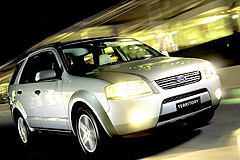News - VFACTS - Sales 2005 - DecemberVFACTS 2005: Small conquers allKing Corolla: After 38 years, Toyota’s perennial small car contender is selling better than ever. In another record year, small was big, large was littler and light was all-right5 Jan 2006 988,269. NOT a million for sure, but as far as new vehicle sales in Australia are concerned, 2005 was still a record year, continuing a four-year growth streak. That’s a 3.5 per cent rise from 2004’s 955,259 total. Of the 988,269, 608,804 were passenger motor vehicles, representing a 3.2 per cent rise over the year before. December 2005 was also a record month, eclipsing the previous best December (2004) by 297 vehicles to achieve 79,277 sales. But it was down on November ‘05’s 83,538 total by 4261 units, continuing a last-quarter sales trend that the Federal Chamber of Automotive Industries (FCAI) says robbed the industry of the one million annual sales result. In 2005, the Holden Commodore led all others for the tenth year in a row with 66,794 units (down from 79,170 in 2004), followed by the Ford Falcon (53,080 versus 65,384). As expected, large cars fell, by 15.7 per cent to 153,244 units. The previous year’s result was 181,678. Other ‘Big Six’ casualties included the Camry V6 (down 2024 units to 12,046) and ailing Toyota Avalon (2949 versus 5584 sales in 2004. Mitsubishi’s family car situation is disheartening despite a numerical improvement. Just 16,017 Magna, Verada and all-new 380 models were sold last year, representing a mere 49 more cars over what the former two achieved in 2004. The 380 deserves better. In contrast – and not coincidentally – the big winner was the small-car segment, which jumped 18.6 per cent year-on-year to 215,324 sales, breaching the 200,000 mark for the first time. In 2004 the total was 181,160. The Toyota Corolla, which was Australia’s best-selling car overall in September, led the small class with 46,415 sales, up from 39,053. This is an 18.9 per cent rise, and an all-time best for the 38 year-old name plate. The premium-priced Mazda3 continued its startling run with 32,570 cars sold compared to 2004’s 22,046, but it was pipped to second place by Holden’s wider range of Astras (33,070 versus 24,699 in ’04). With an 1837 unit drop in Focus sales in 2005 (10,728 versus 12,565) despite glowing press reviews, Ford must be wondering what it must do to find more buyers for its European small car. Securing 9311 sales (a 57.3 per cent leap over 2004), even the far-costlier VW Golf is closing in on the Focus.  On a brighter side for Ford, Sport Utility Vehicle (SUV) sales lifted 4.2 per cent to 180,292, an achievement due in no small part by its Territory (23,454 sales) that, according to FCAI chief executive Peter Sturrock, “… had been one of the highlights of the 2005 model year”. On a brighter side for Ford, Sport Utility Vehicle (SUV) sales lifted 4.2 per cent to 180,292, an achievement due in no small part by its Territory (23,454 sales) that, according to FCAI chief executive Peter Sturrock, “… had been one of the highlights of the 2005 model year”.In that SUV Medium sector the revamped Hyundai Terracan, Holden Adventra V6, Jeep Wrangler, Kia Sorento, Nissan Pathfinder and Land Rover Discovery also lifted their sales. Honda must be pleased with the hard-charging Accord/Accord Euro duo (17,579 versus 12,564), which not only blitzed the second-placed Maxima (2808 sales – 47.3 per cent down on ‘04’s 5329 result) in its prestige segment but also outsold the Mazda6 (14,783) in the cheaper medium segment. Only the 24,446 Toyota Camry 2.4s sold stood in its way. Nevermind, the 3543 Odyssey people movers Honda shifted in 2005 (against 2129 the year before, and only 891 units shy of the segment-leading stalwart, the Kia Carnival), as well increased Jazz sales (7914 compared to 7360) must have made up for it. Speaking of light cars, Toyota is leading the category thanks to a seamless transition from the big-selling Echo to its Yaris replacement. Together they found 18,832 buyers compared to 17,879 in 2004. And this is in spite of Hyundai’s growing Getz threat (16,455) as well as the record 9675 Barina sales that Holden achieved. Yet Suzuki stole the baby limelight by having its new Swift sell almost 31 times better last year than its Ignis predecessor did in 2004. The light commercial vehicle tally was also up, by 2.6 per cent to 167,878, with strong showings by the Holden Rodeo, Mitsubishi Triton, Ford’s ageing Courier and Toyota’s revitalised HiLux pick-up and HiAce van. Overall in 2005 then, Toyota led the pack again – the tenth non-consecutive year to do so – with 202,817 sales – just 1080 units more than 2004’s record-busting 201,737 sales. But Holden (at 174,464) and Ford (at 129,140) faltered against the previous year’s respective 178,027 and 135,172 totals. They also, along with Toyota and Nissan, lost market share in 2005. A surging Mazda filled out the fourth place with 66,250 sales (all its passenger cars bar the RX-8 and geriatric MPV grew in sales), followed by Mitsubishi’s 61,907 sales – up from a disastrous 56,967 previously), and then Nissan at 56,032 against 63,654 in ’04 when it sat at number four. The Tiida, Nissan’s imminent Pulsar replacement, can’t come soon enough, as the X-Trail – second with 12,072 sales in the light SUV segment behind Subaru’s facelifted Forester (12,320) – will face a fierce foe in Toyota’s all-new RAV4 (which finished third with 11,881 sales) in 2006. Improvers rounded out the top ten, with Hyundai registering 48,010 vehicles against 42,510 and Honda hitting 47,001 versus 36,474, Subaru set a personal best of 36,044 (up from 33,619) while Kia shifted 25,293 vehicles against the previous year’s 24,454. Soaring Suzuki, thanks to the Swift, virtually doubled its sales from 7206 to 13,794, while Volkswagen, too, shot up, to 15,782 units from 10,754, representing a 46.7 per cent difference. Other ascendants included Smart (60.1 per cent), Proton (57 per cent) Mini (39.9), Audi (29.9 per cent), Citroen (25.2 per cent), Lexus (19.9 per cent) and Jeep (12.8), while BMW, Chrysler, Volvo and Mercedes-Benz also recorded rises. The resurrected Ssangyong’s 2645 VFACTS result was ahead of 2004’s non-VFACTS tallied 1106 vehicles. Distributors that saw sales slow significantly are the departing Daihatsu (5010 versus 3007 in ‘04), Saab (1510 versus 1848) and Alfa Romeo (1572 versus 1800), while Jaguar and Renault also slid back. Since 2001 over 200,000 (or 27 per cent) more new cars and trucks were sold. For 2006, the FCAI is predicting 980,000 units for the second year in a row. “While general economic conditions will soften in 2006, the motor vehicle market will stabilise at its current level of strength,” Mr Sturrock says. The FCAI chief also believes that 2005 confirmed the continuing evolution of buyer habits. “Private buyers and fleets are adjusting their purchasing patterns to suit their changing needs, including their views on the effect of petrol pricing and running costs,” Mr Sturrock said. Nevertheless he envisages a large-car segment recovery courtesy of significantly new or revised players. “Two manufacturers are planning the launch of (new) models on top of Mitsubishi’s recently released 380 and Ford’s upgraded (BF) Falcon,” Mr Sturrock added. Market leader Toyota’s executive director of sales and marketing, David Buttner, concurs with both the FCAI’s market forecasts and the large car’s new product-led resurgence. However he believes it will be a slow recovery, as both the upcoming Holden VE Commodore and Toyota Avalon replacement won’t be released until well into the second half of 2006. “They’re coming too late in the year (the large segment) to fully recover the 16 per cent fall it experienced in 2005,” he told GoAuto, predicting that their full impact won’t be felt until 2007, which is also when Ford’s BF Falcon replacement is due. “In Australia there will always be demand for large cars… (especially) if you are offering the right ‘Large Six’ with the right space, the right fuel economy and at the right price – but it also has the right looks too.” Mr Buttner also thinks that the mid-sized passenger car and medium SUV segments will probably return some of the market share they stole from the large-car segment. “It will not be easy in 2006,” he admits. “With the same levels of sales expected as last year, and with Toyota seeking growth, we need to achieve more conquest sales as well as to hold on to the loyal customers. “This is the challenge.” Here are the top ten sellers of 2005 and their market share, with the 2004 percentage in brackets. 1. Toyota: 20.5% (21.1%) 2. Holden: 17.7% (18.6%) 3. Ford: 13.1% (14.2%) 4. Mazda: 6.7% (5.8%) 5. Mitsubishi: 6.3% (6.0%) 6. Nissan: 5.7% (6.7%) 7. Hyundai: 4.9% (4.5%) 8. Honda: 4.8% (3.8%) 9. Subaru: 3.6% (3.5%) 10. Kia: 2.6% (2.6%) |
Click to shareVFACTS articlesResearch VFACTS Motor industry news |














Facebook Twitter Instagram